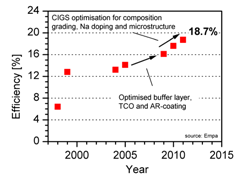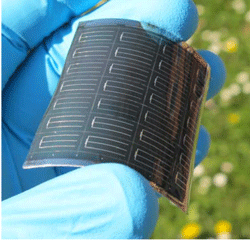- News
19 May 2011
Swiss team claim world record efficiency for flexible CIGS solar cells on plastics
A Swiss research team at Empa's Laboratory for Thin Film and Photovoltaics, led by Ayodhya N. Tiwari, have increased the energy conversion efficiency of copper indium gallium (di)selenide (CIGS) flexible solar cells to a world record of 18.7% (the previous record of 17.6% was achieved by the same team in June 2010). The measurements have been independently certified by the Fraunhofer Institute for Solar Energy Systems in Freiburg, Germany.
 "The new record value for flexible CIGS solar cells of 18.7% nearly closes the "efficiency gap" to solar cells based on polycrystalline silicon (Si) wafers or CIGS thin film cells on glass", says Tiwari. He adds that "...flexible and lightweight CIGS solar cells with efficiencies comparable to the "best-in-class" will have excellent potential to bring about a paradigm shift and to enable low-cost solar electricity in the near future."
"The new record value for flexible CIGS solar cells of 18.7% nearly closes the "efficiency gap" to solar cells based on polycrystalline silicon (Si) wafers or CIGS thin film cells on glass", says Tiwari. He adds that "...flexible and lightweight CIGS solar cells with efficiencies comparable to the "best-in-class" will have excellent potential to bring about a paradigm shift and to enable low-cost solar electricity in the near future."
Graphic: Improvement in energy conversion efficiency of flexible CIGS solar cells on polymer film.
According to the team, one advantage of flexible high-performance CIGS solar cells is the potential to lower manufacturing costs through roll-to-roll processing while at the same time offering a much higher efficiency than the ones currently on the market. Furthermore, lightweight and flexible solar modules offer additional cost benefits in terms of transportation, installation, and structural frames for the modules.
 In conjunction with scientists at FLISOM, a start-up company that is scaling up and commercializing the technology, Empa’s team made progress in low-temperature growth of CIGS layers yielding flexible CIGS cells that are ever more efficient, up from a record value of 14.1% in 2005 to the new record of 18.7% for any type of flexible solar cell grown on polymer or metal foil. The improvements in cell efficiency were made possible through a reduction in recombination losses by improving the structural properties of the CIGS layer and the proprietary low-temperature deposition process for growing the layers as well as in situ doping with Na during the final stage. With these results, polymer films have for the first time proven to be superior to metal foils as a carrier substrate for achieving highest efficiency, claims the team.
In conjunction with scientists at FLISOM, a start-up company that is scaling up and commercializing the technology, Empa’s team made progress in low-temperature growth of CIGS layers yielding flexible CIGS cells that are ever more efficient, up from a record value of 14.1% in 2005 to the new record of 18.7% for any type of flexible solar cell grown on polymer or metal foil. The improvements in cell efficiency were made possible through a reduction in recombination losses by improving the structural properties of the CIGS layer and the proprietary low-temperature deposition process for growing the layers as well as in situ doping with Na during the final stage. With these results, polymer films have for the first time proven to be superior to metal foils as a carrier substrate for achieving highest efficiency, claims the team.
Picture: Flexible thin film CIGS solar cell on polymer substrate developed at Empa (Copyright: Empa).
Record efficiencies of up to 17.5% on steel foils covered with impurity diffusion barriers were so far achieved with CIGS growth processes at temperatures exceeding 550°C. However, when applied to steel foil without any diffusion barrier, the proprietary low temperature CIGS deposition process developed by Empa and FLISOM for polymer films easily matched the performance achieved with high-temperature procedure, resulting in an efficiency of 17.7%. The results suggest that commonly used barrier coatings for detrimental impurities on metal foils would not be required.
"Our results clearly show the advantages of the low temperature CIGS deposition process for achieving highest efficiency flexible solar cells on polymer as well as metal foils", says Tiwari.
Empa director Gian-Luca Bona added: "What we see here is the result of an in-depth understanding of the material properties of layers and interfaces combined with an innovative process development in a systematic manner. Next, we need to transfer these innovations to industry for large scale production of low cost solar modules to take off."
Empa scientists are currently working with FLISOM to further develop manufacturing processes and to scale up production. The projects were supported by the Swiss National Science Foundation (SNSF), the Commission for Technology and Innovation (CTI), the Swiss Federal Office of Energy (SFOE), EU Framework Programmes as well as by Swiss companies W.Blösch AG and FLISOM.
CIGS solar cells CIGS solar cells on plastics
